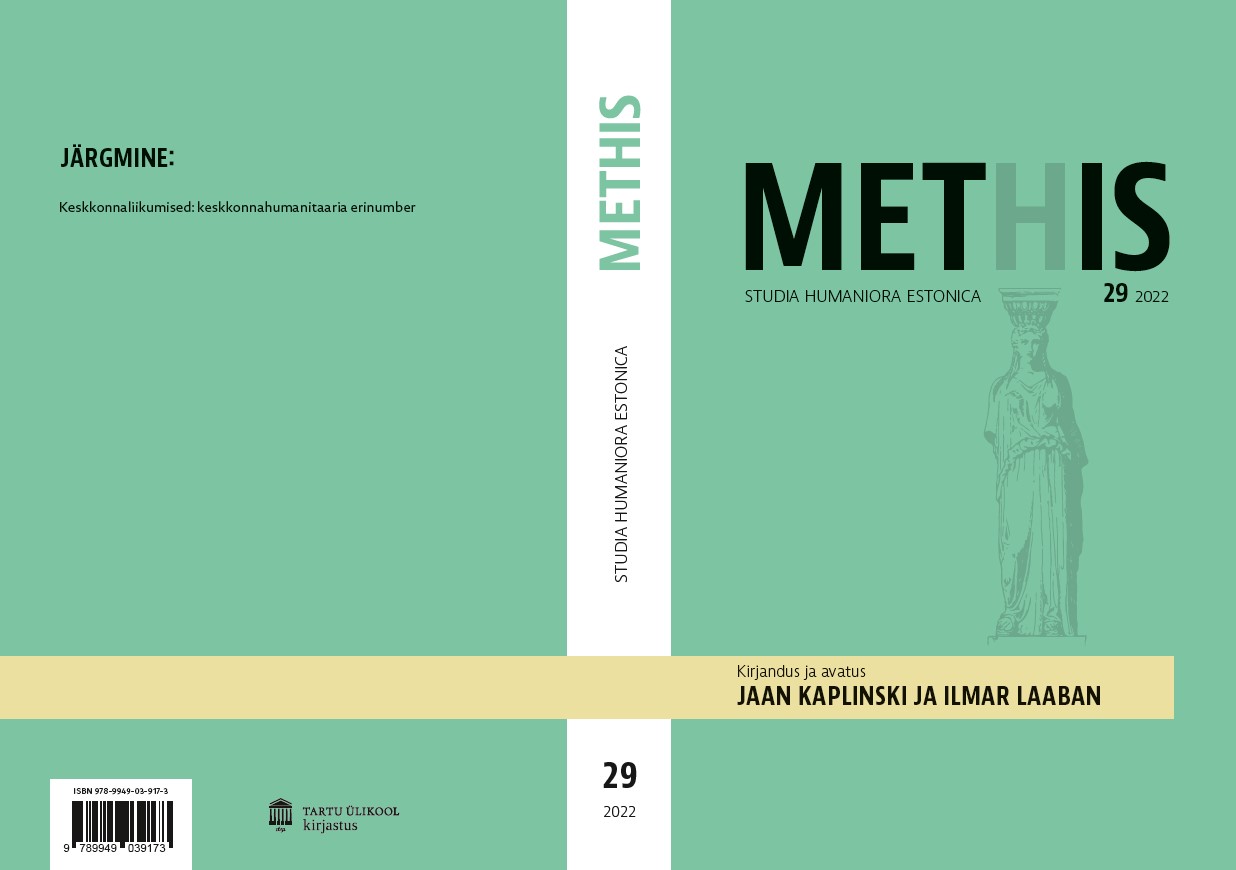Tuulest tulek. Jaan Kaplinski luule tuuline maailm / Coming from the Wind: The Windy World of Jaan Kaplinski’s poetry
DOI:
https://doi.org/10.7592/methis.v23i29.19033Keywords:
Jaan Kaplinski, eesti luule, looduskirjandus, tuul, ilm, mütoloogia, Estonian poetry, nature writing, wind, weather, mythologyAbstract
Artikkel käsitleb tuule esinemisviise Jaan Kaplinski luuleloomingus, vaadeldes neid peamiselt kultuuriloolise ja fenomenoloogilise rõhuasetusega looduskirjanduse poolt pakutavas raamistikus. Kaplinski poeetilises ilmas võib juba olemuslikult avatusega seotud, tõkkeid ületav tuul kaasa aidata luuletuste avarama geograafilise või luulemina poolt vahetult aistitava ruumi mitmemõõtmelisele ülesehitamisele või seostuda eri traditsioonidest pärinevate religioossete ja mütoloogiliste kujutelmadega, esineda personifitseeritult või kosmoloogilise maailmaloova nähtusena. Kirjaniku tuuletõlgendused tõusevad traditsioonilisema, tuult eelkõige metafoorina kasutava poeetilise lähenemise taustal jõuliselt ning omanäoliselt esile.
---
There is an international anthology of wind literature entitled Nobel Winds and Breezes (2009) that has come into existence because of the hunch its would-be compiler Alexande Mohr had about people’s awareness of the wind in daily life, in comparison with which literature seemed to prefer showcasing rare and spectacular storms rather than mundane winds that would affect people’s everyday behaviour. To check this hypothesis, Mohr compiled the anthology, asking how Nobel laureates from the period 1901-2008 have employed the motif of the wind, what aspects of the phenomenon they have rendered to their readers, how they have used it in structuring their works, and what kind of wind experiences they have found worth sharing. These questions form a backdrop for the present article’s discussion of wind as it emerges in Jaan Kaplinski’s poetry. To create a more detailed context for the observation of Kaplinski’s winds, the article charts some dimensions of the treatments of the wind that have been brought into relief in the relevant works by such nature writers, phenomenologically inclined philosophers and ethnographers as David Abram, Jan DeBlieu, Tim Ingold and Lyall Watson. Their ideas and suggestions are set side by side with Kaplinski’s own take on the wind that attributes to it characteristics of a mythological or religious divine breath, and, accordingly, compares it to a source of inspiration in creating both life and poetic art.
The ensuing discussion sets out to detect the occurrences of winds and their different facets in Kaplinski’s poetry and compares these with the conceptualisations presented above. The dimension to head the list of wind manifestations in Kaplinski’s poems is the wind that emerges as a geographical phenomenon – the real wind, as it were. Such wind can be characterised by the direction from which it is blowing, it introduces different elements of the weather and can overcome spatial distances, boundaries and obstructions. This type of wind can be directly experienced with the help of the senses and it contributes to the constructing of the sensory space of the poems. In addition to this type, what is also significant in Kaplinski’s work is the mythological wind that can roam across the whole of the universe; it has a role in human creativity and an ability to cross the boundaries of the sensible world as well as those between the human interior space and the realm external to it. In addition to these, two minor yet distinct kinds of wind can be detected in Kaplinski’s poems. There is the personified wind who materialises as a character that may boast certain features of a trickster figure, with whom humans can communicate, and who displays vague elements of being embodied or having a particular nature; and, last but not least, a type of wind that emerges in Kaplinski’s verse is the cosmological wind that is not contained within the world, but appears to be an inherent part of its structure as a synecdochal pars pro toto side by side with the Sun.
In comparison with the map of Nobel winds provided by Mohr, Kaplinski’s windy world stands out as deviating from the emerging patterns, even though the methodology used in compiling the anthology may admittedly have affected the results and rendered the material too generalised to draw conclusions on any particular author’s poetics in comparison with it. Still, also a survey of wind motifs in earlier Estonian poetry conducted by the literary scholar Õnne Kepp displays results that appear to be considerably more metaphoric than Kaplinski’s multi-dimensional conceptualisation of the notion. Thus it can be suggested that Kaplinski’s idiosyncratic poetics of the wind stands out as a complex original creation full of multifaceted and surprising observations of the natural phenomenon.


